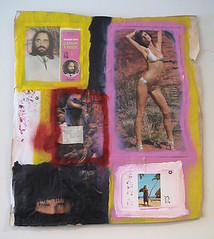

A newly released book
Sähkömetsä - Videotaiteen ja kokeellisen elokuvan historiaa Suomessa 1933-1998 ("Electric Forest - The history of video art and experimental cinema in Finland 1933-1998") -- edited by Kirsi Väkiparta, lavishly illustrated and published by
Kuvataiteen keskusarkisto (Central Art Archives of Finnish National Gallery) -- is the first attempt to trace the complete history of Finnish media art in cinema and video. The book features such writers as film director
Mika Taanila, researchers Hannu Eerikäinen and Kari Yli-Annala, and Perttu Rastas, who has specialized in video and media art since the mid-80s.
As the starting point of Finnish experimental cinema Mika Taanila has chosen Armas Jokinen's surrealistic short film
Vappuhumua of 1933. A major name here must be the visual artist
Eino Ruutsalo, who created in 1962-67 his experimental shorts where he painted and wrote directly to film, scratched it and pinned holes to it. Ruutsalo's films -- in their visual narrative not so different from some modern music videos, in fact -- featured music and sounds from such people as jazz composer
Henrik Otto Donner and electronic music pioneer
Erkki Kurenniemi (who also created some experimental film works of his own). The underground rock culture of the late 60s brought along a new generation of cinematic experimentalists, when such people as Peter Widén of
The Sperm group showed his films on the band's gigs, often intending to shock and provoke; Taanila notifies that most of these works have sadly disappeared now.
What remains of Widén's works is a fifteen minutes excerpt of
Suomen Talvisota (1970), documenting the band rehearsals of
Suomen Talvisota 1939-1940, a controversial rock/performance group featuring such luminaries of Finnish underground as
M.A. Numminen. The group members and poets
Markku Into and the late
Jarkko Laine are seen in the film; also Finland's legendary President Urho Kekkonen is featured here, laying the cornerstone for Helsinki's Finlandia Hall in the cross-cut film excerpts!
Also Timo Aarniala, these days best known as the underground comics artist and for his record sleeves (
Underground-Rock by Suomen Talvisota 1939-1940 of 1970 probably being the most famous of them) did his share in the field of experimental cinema: among those works a 1968 short consisting of nothing else but the ever-repeating loop of the 20th Century Fox logo and that familiar fanfare... in music,
J.O. Mallander's famous 'Kekkonen' (also 1968) perused exactly the same minimalist idea.
The late 70s punk movement inspired in Finland such experimental film-makers as
Pasi "Sleeping" Myllymäki, working in Super-8 format. Myllymäki, born in 1950, was about a decade older than the punk generation but was especially excited with its fanzine boom; also editing his own zine
Maanalainen kaitaelokuva ("Underground Super-8 Cinema"). He was to create nearly 50 short films in between the years 1976 and 1985.
Any acclaim for the works of Myllymäki and his collaborator Risto Laakkonen was slow in coming, but finally ten of these films were taken to the collection of Stockholm's Museum of Modern Art, and receiving screenings also around Europe and United States. However, by the mid-1980s Myllymäki's interest in experimental cinema started to wane.
This was also the era when video gradually started to replace film as the favourite medium of experimental artists, being cheaper to use -- and of course, being recyclable. (Perttu Rastas adds, though, that there were some Finnish experiments in video already in the 1960s and 70s.)
Of the later experimental film/video works a mention is deserved to such creators as Taanila himself,
Ilppo Pohjola and
Eija-Liisa Ahtila (at the moment internationally one of the most acclaimed Finnish visual artists whose
Love Is A Treasure (2002) is even featured in the collections of MoMA); also to
Sami van Ingen,
Seppo Renvall,
Veli Granö,
Teemu Mäki,
Anneli Nygren, Mox Mäkelä,
Marikki Hakola, Matias Keskinen,
Mikko Maasalo… and the team of
Jimi Tenor (better known as a musician, of course) and Jusu Lounela, with their notorious forays into bad taste with such works as
Urinator and
Dr. Abortenstein.
(As main sources here have been used Harri Römpötti's newspaper article "Kaitafilmiltä videolle, maan alta galleriaan",
Helsingin Sanomat 30 April 2007, and the
Turun Sanomat interviews of Mika Taanila and Pasi "Sleeping" Myllymäki, linked below.)
Related links in English:
Sähkömetsä screenings @ Avanto Festival 2006
Related links in Finnish:
Kirjan esittely Kuvataiteen Keskusarkiston sivulla
Maanalainen Suomi @ Kinoklubi/YLE Teema
Pasi "Sleeping" Myllymäen haastattelu Turun Sanomissa 26.4. 2007
Mika Taanilan haastattelu Turun Sanomissa 26.4. 2007
Sähkömetsä II @ SEA
Sedis kommentoi
Uusi suomalainen kokeellinen elokuva Filmihullussa
pHinnWeb:
FinnScene: The Early Years





















